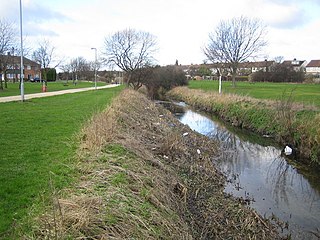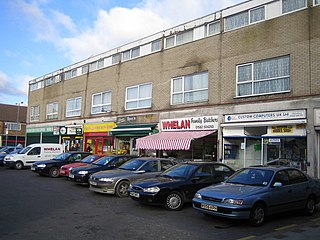
Luton is a town and unitary authority with borough status in Bedfordshire, England, with a population at the 2021 census of 225,262.

Bedfordshire is a ceremonial county in the East of England. It is bordered by Northamptonshire to the north, Cambridgeshire to the north-east, Hertfordshire to the south and the south-east, and Buckinghamshire to the west. The largest settlement is Luton (225,262), and Bedford is the county town.

Kenilworth Road, known affectionately as The Kenny, and The Old Girl, is an association football stadium in Bury Park, Luton, Bedfordshire, England. It has been the home ground of Luton Town since 1905. The stadium has also hosted women's and youth international matches, including the second leg of the 1984 European Competition for Women's Football final.

Toddington is a large village and civil parish in the county of Bedfordshire, England. It is situated 5 miles north-north-west of Luton, 4 miles (6 km) north of Dunstable, 6 miles (10 km) south-west of Woburn, and 35 miles north-north-west of London on the B5120 and B579. It is 0.5 miles from Junction 12 of the M1 motorway and lends its name to the nearby motorway service station. The hamlet of Fancott also forms part of the Toddington civil parish.

Houghton Regis is a market town and civil parish in the Central Bedfordshire district of Bedfordshire, England.

Luton Rural District was a local authority in Bedfordshire, England from 1894 to 1974. It covered an area which almost surrounded but did not include the towns of Luton and Dunstable.

Limbury is a suburb of Luton, in the Luton district, in the ceremonial county of Bedfordshire, England, and was formerly a village before Luton expanded around it. The area is roughly bounded by Bramingham Road to the north, Marsh Road to the south, Bramingham Road to the west, and Catsbrook Road, Runfold Avenue, Grosvenor Road, Bancroft Road and Blundell Road to the east.

Leagrave is a former village and now a suburb of Luton, in the Luton district, in the ceremonial county of Bedfordshire, England, in the northwest of the town. The current council ward is roughly bounded by Vincent Road, Torquay Drive and High Street to the north, Roman Road and Stoneygate Road to the south, the M1 to the west, and Marsh Road and Leagrave Park to the east.
Lewsey is a suburb of Luton, about 3 miles (4.8 km) west north-west of the town centre, and a ward of the Borough of Luton, in the ceremonial county of Bedfordshire, England. The suburb is roughly bounded by Leagrave High Street to the north, Dunstable Road to the south, Poynters Road, Dunstable to the west, and the M1 to the east.

Hockwell Ring is a suburb of Luton in the north-west of the town, in Bedfordshire, England. The area is roughly bounded by Brickly Road to the north, High Street and Torquay Drive to the south, the M1 motorway to the west, and Vincent Road to the east.

Sundon Park is a suburb of north Luton, in the Luton district, in the ceremonial county of Bedfordshire, England. The area is roughly bounded by the edge of Luton to the north, Leagrave Park to the south, the Midland Main Line to the west, and Spinney Woods and the footpath from the woods to the edge of town to the east.

Round Green is a suburb of Luton just over 1 mile (1.6 km) north-east of the town centre, and a ward of the Borough of Luton, in the ceremonial county of Bedfordshire, England. The area is roughly bounded by Bradgers Hill to the north, People's Park, Richmond Hill and Turners Road South to the south, Wardown Crescent and Elmwood Crescent to the west, and Vauxhall Way to the east.
Challney is a district in Luton, in the Luton district, in the ceremonial county of Bedfordshire, England, off the main arterial road leading from Luton into Dunstable. The area is roughly bounded by Rodheath, Stoneygate Road, Roman Road, and Beechwood Road to the north, Hatters Way to the south, the M1 to the west, and Waller Avenue and Chaul End Lane to the east.
Luton is a town located in the south of Bedfordshire, England.

Dunstable is a market town and civil parish in Bedfordshire, England, east of the Chiltern Hills, 30 miles north of London. There are several steep chalk escarpments, most noticeable when approaching Dunstable from the north. Dunstable is the fourth largest town in Bedfordshire and along with Houghton Regis forms the westernmost part of the Luton/Dunstable urban area.

High Town is an inner area of Luton immediately north of Luton railway station, and a ward of the Borough of Luton, in the ceremonial county of Bedfordshire, England.
The Bedfordshire Senior Challenge Cup, also known as the Beds Senior Cup is the county cup of Bedfordshire. According to the current rules of the competition, it is open to all clubs whose affiliation is with the Bedfordshire County FA (BCFA). The current holders are Luton Town who won the competition when it was last contested in the 2022/23 season in a 6-2 victory over Biggleswade F.C. in the final.
Luton Stadium was a former greyhound racing and speedway stadium.
Lewsey Farm is a suburb of Luton, Bedfordshire, England. Situated in the north-west of the town, the area is roughly bounded by the Woodside Link to the north, Leagrave High Street to the south, Poynters Road to the west, and Pastures Way to the east. The wider area including nearby districts Lewsey Park and Lewsey are sometimes referred to as Lewsey Farm.
















